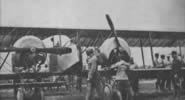In the early hours of August the 15th, 1916, all along the Carpathian's, Romanian troops stood ready to cross the border and put an end to 700 years of injustice and oppression. They took the fight to the enemy and achieved total surprise everywhere the Austro-Hungarian units tried to resist. The 8th and the 6th infantry brigades of the 2nd Army ( 14 battalions, 12 batteries ) advanced on the major city of Brasov, smashing through the lines of the 71st Austro-Hungarian division. They took over 500 prisoners and captured several machine guns during the fighting for the Bran peak alone. The 1st Army also pushed the enemy back, and its 1st Vanatori regiment enjoyed considerable success on the 19th of August, where they captured 450 enemy soldiers and 8 officers.
|
All over the front, the frontier battles ended with the victory of the Romanian forces and by the 20th of August all the vital mountain passes were firmly in Romanian hands. Therefore, the Supreme HQ ordered that the main body of the Northern and 2nd armies cross the border and advance to the Mures, before the enemy could bring in reinforcements.
|
The Northern Army begun to move out on the 24th. Its 14th Infantry Division met heavy enemy resistance near the Leu hill, but after two days of bitter fighting succeeded in overrunning the hill, while its western neighbors also fought hard to take Toplita. On the 26th of August, the 7th Division liberated the city of Miercurea Ciuc and reached the river Olt, capturing the high ground west of the river two days later. The 8th Division also advanced and reached its objective, the Mures, on the 28th. Further to the south, the 2nd Cavalry Division was probing ahead, looking to link up with the right wing of the 2nd Army. Having accomplished its mission, the army stopped and started to dig in, preparing for the eventuality of an enemy counterattack. The 2nd Army's progress was equally good, but much easier, since the enemy opposition was very weak. By the 28th it had also reached its objectives and started to prepare defenses. But things didn't go so smoothly in the western sector, where elements of the 13th and 23rd Infantry Divisions of the 1st Army attacked the positions of the 144th Austro-Hungarian Brigade. It took a hall day before the enemy was thrown back and its position overrun. The 1st Army pushed the enemy back until the 27th, when it was forced to halt the offensive after two of its divisions ( the 2nd and 12th ) were sent to Transilvania. The 3rd Infantry Division was taken from the 3rd Army and attached to the 1st, but it was still in Dobrogea and needed some time before it could reach the front.
|
By the 28th of August 1916, the Romanian army was pretty much on schedule. But now the Central Powers were beginning to deploy fresh forces in Transilvania and Banat. Needless to say, there had been no Allied offensive in Greece ( on the Salonic front ) or Russian one on the east front, so the Germans and Austro-Hungarians were fully capable of dispatching large numbers of troops to the hard-pressed 1st Austro-Hungarian army. Besides from bringing all its units back to full strength and reinforcing its artillery with many batteries, four more divisions ( two infantry and two cavalry ) were added to its roster. Together, the two Romanian armies still outnumbered the enemy, but the difference was far smaller than at the start, and the two armies were still too far apart to reinforce each other quickly, should any of them find itself in trouble.
|
On the 29th of August, the Supreme HQ ordered that the 2nd Army, together with the Northern army's left flank, resume its advance up to the line Homorod-Fagaras. Just the forward elements were to push a few kilometers beyond this line, where the coming enemy counteroffensive was to be checked. Simultaneously, the 2nd Cavalry Division was to capture the city of Odorhei and meet up with units of the 1st Army. The 1st was to hold and reinforce its positions. Three days later, the 3rd and 2nd Corps ( both belonged to the 2nd Army ) launched their attack and reached the Homorod the following day. The 3rd Infantry Division faced strong enemy forces entrenched on the opposite bank of the river Olt, which could be crossed only on a few places. Realizing that a frontal assault would have produced nothing but heavy casualties, the commanders looked for another solution. A young peasant girl, Maria Manciulea, led a small force across the river during the night of the 3rd of September, undetected by the Austro-Hungarian troops. The Romanian forces launched simultaneous attacks from the front and rear of the enemy positions, throwing them back in disarray. For her actions, Maria Manciulea received the "The Military Virtue", the highest Romanian award. Another attack was carried out by the 4th Division, which also crossed the Olt, overran the enemy defenses and secured the town of Fagaras by September the 4th.
|







